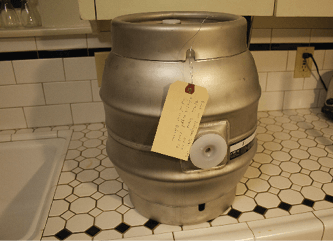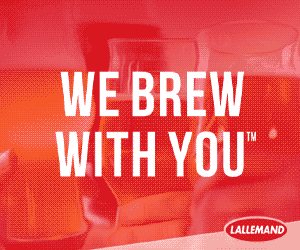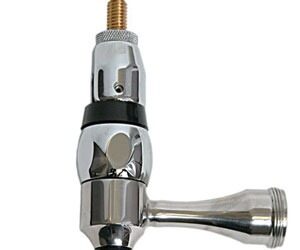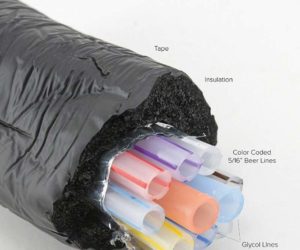Improve Your Cask Conditioned Beer

effort to grow top-quality barley for brewing. British farmers work from a list
of approved barley varieties, and these varieties command a premium price over
feed varieties. Barley varieties with exotic-sounding names such as Maris
Otter, Halcyon, Pipkin and, in Scotland, Golden Promise are as much a part of
the recipe as a particular hop variety.
They tend to be malted more slowly than American two-row,
resulting in less grain-to-grain variation. They are also kilned to a lower
moisture content, making them easier to mill with a two-roller mill, easier to
use in an infusion mash, less prone to sulphury flavors, stronger in flavor,
and darker in color.
As a professional brewer, I have found that to get the best
extract from an American two-row malt you need a high mash temperature (156°
F). If you are using a single-temperature infusion mash, then this precludes
you from producing a highly fermentable wort and therefore a dry-finishing
beer. Using well-modified English malt will allow you to mash at a lower
temperature, favoring fermentability, and still get a reasonably high extract.
I have found that imported crystal malt seems to provide sweeter caramel
flavors and colors with a reddish hue, compared with domestic caramel malt,
which provides drier, spicier characters and a brown color.
________________
Cask-Conditioned Beer
The Oxford English Dictionary definition of real ale is: “A
name for draft (or bottled) beer brewed from traditional ingredients, matured
by secondary fermentation in the container from which it is dispensed, and
served without the use of extraneous carbon dioxide.” The details are open to a
multitude of interpretations but essentially:
After primary fermentation the beer is transferred to the
serving container.
Residual sugars in the wort or added sugars (primings) feed
the secondary fermentation.
Carbonation and flavor maturation occur naturally in that
container.
Whole hops can be added for the duration of maturation and
serving.
Yeast either sediments out naturally or with the aid of a
fining agent.
Either way the beer should still be brilliantly clear.
The beer is served at cellar temperature (50° to 55° F).
The carbonation should be low (1 to 1.4 volumes).
The beer should be pulled from the container by a suction
pump or allowed to flow by gravity.
It should be the most complex, delicious, satisfying beer
you’ve ever had.
________________
Hops
British brewers use hops at a rate of less than two ounces
of medium alpha acid hops (4 percent to 5 percent) per five-gallon batch and
mostly use whole-flower hops. While professional brewers have gone away from
dry hopping over the years, there’s no reason the homebrewer need follow suit.
Hops floating around the dispense container, though, will seriously interfere
with the dispense equipment, so containing the hop leaves in some kind of bag
is recommended. Don’t obsess too much about sterility when dry hopping, partly
because you can’t sterilize hops but mainly because they act as their own
preservative.
Fermentation
Homebrewers of cask beer have an advantage over their
professional counterparts in this country in that they are able to devote an
entire batch to cask conditioning rather than diverting a few kegs from a full
batch destined to be filtered, carbonated, and kegged. This makes it easier to
arrest the fermentation with one or two specific gravity degrees still left and
to remove the bulk of the yeast prior to conditioning.
Conditioning
A lot of articles on cask conditioning suggest adding a
clarification aid such as isinglass as the beer is transferred to the cask.
Commercial brewers in the United Kingdom now allow the yeast to remain in
contact with the beer for the maturation phase and add finings only when the
beer is required for shipping or dispense. This is because finings are very
efficient at settling yeast to the bottom of the container and once there, the
yeast can’t do much fermenting. Some brewers even go to the trouble of rolling
unfined, maturing casks in the warehouse occasionally to keep yeast in
suspension in contact with the beer. Cask beer is best drunk while it is young,
but it should be easy enough to sample it regularly and judge for yourself.
Homebrewers who bottle condition already know that yeast,
sealed up in a container with some sugars to ferment, will produce carbon
dioxide gas. This gas cannot escape and so will dissolve in the beer, causing
the beer to become carbonated. The colder the beer the more CO2 will dissolve,
but since the gas comes from fermentation and ale yeast cannot ferment much
below 50° F, there is a limit to the amount of carbonation that can be achieved
without excessive pressure being generated.
Certain flavors that may or may not be appropriate in your
beer, such as diacetyl (butterscotch flavor) and acetaldehyde (green apples),
can only be removed by actively fermenting yeast. If the yeast is stuck on the
bottom of the cask having been fined, then it can do little to remove these
flavors.
Since cask-conditioned beer will be served without top
pressure, only a low (0.9 to 1.2 volumes) level of carbonation is possible.
That, coupled with a slightly warmer serving temperature than keg beer, results
in a greater perception of the multitude of flavors a cask beer can exhibit.
Take into account using the flavorful barley varieties of English malt, dry
hopping, and natural clarification aided by finings, and you will see that the
entire process is geared toward intensifying these flavors.
Clarification
While some believe that finings aid in the removal of
proteins, this is not the case. Finings such as isinglass and gelatin are only
capable of causing yeast to sediment out more rapidly. British brewers
shouldn’t have to worry too much about protein haze because British malt is low
in protein and using kettle finings during the boil helps dramatically.
Commercial brewers in the United Kingdom use an auxiliary fining agent for
protein removal. Beers served at cellar temperature of 50° F are less likely to
throw a chill haze.
While isinglass is readily available, it is very unstable at
high temperatures and may lose all its activity if it is allowed to get too
warm (over 70° F). It will also only clarify the beer up to four or five times,
so if the fined beer is moved around too often, it will not clarify. It is also
possible to overfine, resulting in a sediment that floats up a little off the
bottom of the dispense container, and the same effect can occur if the finings
are not extremely well mixed with the beer.
If your finings come with instructions that tell you to add
them to boiling water, then you are using porcine (pork-based) gelatin as a
clarification aid. This has been known to upset the occasional vegetarian cask
beer enthusiast.
Dispense
If you have fined the cask and pressure has built up inside
due to fermentation, the cask must be vented to atmospheric pressure before
dispense. Do not suddenly release that pressure, because the sediment will be
roused by the sudden release of gas and may not settle back down. If the
sediment does get disturbed, it is often a good idea to roll the cask to remix
the finings and yeast and then to allow it to completely resettle.
Some yeast can produce a lot of sulphur during the secondary
fermentation, but that will collect in the headspace gas and can be vented away
occasionally.
During dispense, if air is allowed to contact the beer, then
the container should be emptied in two or three days at the most. If you intend
to keep the beer longer, then a blanket CO2 pressure (0.25 psi) will help
preserve the beer’s freshness. Oxidation causes a loss of fresh hop aroma and a
souring of the beer. The beer should not have a hint of vinegar, although that
is a common character in English pub beers, particularly during the summer.
If you decide to purchase a beer engine or build yourself a
handpump, then there are a couple of things to remember. They are designed to
pull beer out of the cask but offer no resistance to forward flow. Any pressure
in the cask will force beer forward through the pump without pulling on the
handle, resulting in a huge mess and a loss of beer.
If the beer is carbonated to 1.8 to 2 volumes of CO2, then a
sparkler attachment may be unnecessary. On most beer engines sparklers are
removable. Remember to rinse the pump out with water between tasting sessions,
because beer left in the lines and pump can quickly ruin the system.



